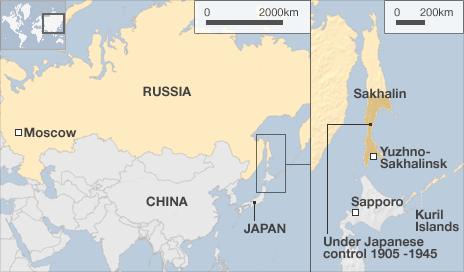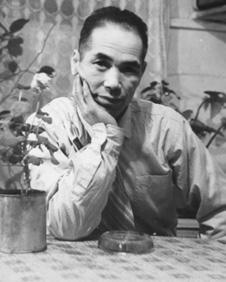Sakhalin memories: Japanese stranded by war in the USSR
- Published
Sakhalin: Japanese residents remember
"My mother always said she wanted her children to return and live in Japan," says 61-year-old Fumiko Furihato, whose family was stranded in Soviet territory at the end of World War II.
Ms Furihato, who now lives in the Japanese city of Sapporo, cannot talk about her father and mother without bursting into tears.
She spent most of her life living on Sakhalin - a 1,000km-long (600 miles) island that Japan ceded to the Soviet Union after the war. The southern half of the island was part of Japan from 1905 to 1945, a thriving outpost of the empire, and home to hundreds of thousands of Japanese.
Ms Furihato's father Tosikatsu worked on a lighthouse on Sakhalin. When Soviet troops invaded in August 1945, her father had to stay behind because of his work, and the family missed the last boat out.
"My father was in complete shock at first," says Ms Furihato, sobbing while she speaks.
"He obviously missed Japan a lot. He was always listening to Japanese radio and I could see tears in his eyes. But I felt particularly sorry for my mother, who had to bring up eight children and didn't even have enough time to learn Russian."
As the Soviet Union consolidated its control on Sakhalin in the late 1940s, life was extremely difficult for the Japanese citizens left behind. The Furihato family lived in one room in an old barracks.
Occasionally, by agreement, the Japanese government would send a ship to collect some stranded citizens, but the Furihatos were often unaware of the sailings.
On one occasion they did hear about a boat, but one of the children had a badly broken leg and could not travel. Ms Furihato's mother, Yo, decided that all the family should stay behind.
"My mother once told me when I was an adult how sorry she was that we weren't able to return to the land of our ancestors, and had to grow up in Sakhalin," says Ms Furihato.
When the Soviet Union collapsed, she did return to Japan. She now lives with her Ukrainian husband and their two daughters in a small subsidised flat in Sapporo, the main city on the Japanese island of Hokkaido.
At the nearest point Hokkaido and Sakhalin are only 40km apart, but she has never been back to the island where she was brought up.
Bright future denied?
Sakhalin is no longer a flashpoint in Russia-Japan relations, but the two countries are still locked in a poisonous dispute over some of the islands in the nearby Kuril chain. Sakhalin's prospects have been severely hampered by the row.
Transport links between Japan and Sakhalin are few - just two flights and two ferries a week in summer. And trade in the area is limited - consisting mostly of natural gas going from Russia to Japan, and old ships piled high with used cars going in the other direction.
The ferry journey across the La Perouse strait takes about five hours - from a neat small Japanese port in Hokkaido to a run-down Russian facility where the remains of the once-thriving fishing fleet lie rusting in the shallows.
Between 1905 and 1945, the Japanese invested heavily in southern Sakhalin, which they called Karafuto. They built railways and factories including a big pulp and paper plant. But apart from the narrow-gauge railway track, there is little evidence left of their presence. The only significant Japanese building remaining in the island's capital Yuzhno-Sakhalinsk is now the regional museum.

Sakhalin's ports have all the hallmarks of Soviet decay and neglect
Yuzhno-Sakhalinsk, with a population of about 180,000, is the biggest city on Sakhalin. An eight-hour flight from Moscow, it is a typical Soviet city, with a few wide avenues and hundreds of residential blocks packed with claustrophobic flats. The infrastructure looks poor, and there is little hint of the gas wealth offshore.
The city feels completely Russian, though the damp Pacific climate and the lush foliage on Sakhalin feel like Asia. Outside the city much of Sakhalin is untouched forest under grey clouds. In summer the rivers teem with salmon returning to spawn.
If World War II had ended a few weeks earlier, Yuzhno-Sakhalinsk could well have been a shiny bustling Japanese metropolis today, and southern Sakhalin would be criss-crossed with modern railways and roads.

Japanese resurgence
Although those developments never took place, the story of the Japanese on the island continues. Some of those left behind when Japan's imperial army withdrew still live on Sakhalin.

Tosikatsu Furihato felt he had to stay behind in Sakhalin because of his job
Yelena Kon, 67, is the director of Furusato, a Japanese restaurant in Yuzhno-Sakhalinsk. It is one of the new Japanese-owned businesses that are starting to open once more on Sakhalin.
Her mother had moved to Sakhalin in the 1930s and married a Korean. He was not welcome in Japan when the war ended, so they stayed and became Soviet citizens.
If they had thought he was safe on Sakhalin, they were wrong. In 1946 he was detained and taken to the Gulag in Siberia where he stayed until he was released in 1953.
Ms Kon still remembers it vividly: "At school I really suffered because my mother was Japanese and my father was a political prisoner."
Her uncle came over from Japan to take the family home, but she refused to leave because her husband was still being held in Siberia.
"My mother once told me we would have had a very different life if we had left when my father was in prison. It was very hard for her to survive with three children to feed," she says.
She has never told her story before.
"I never thought I would tell these secrets about my family. I was scared. All my life I was just very scared."
- Published12 July 2011
- Published7 February 2011
- Published1 November 2010